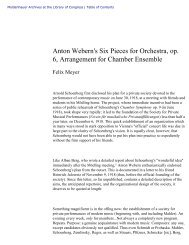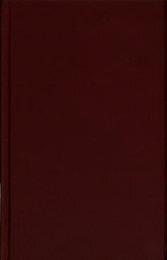Country Profile: Cuba - American Memory - Library of Congress
Country Profile: Cuba - American Memory - Library of Congress
Country Profile: Cuba - American Memory - Library of Congress
Create successful ePaper yourself
Turn your PDF publications into a flip-book with our unique Google optimized e-Paper software.
<strong>Library</strong> <strong>of</strong> <strong>Congress</strong> – Federal Research Division <strong>Country</strong> <strong>Pr<strong>of</strong>ile</strong>: <strong>Cuba</strong>, September 2006<br />
Natural Resources: In addition to arable land, <strong>Cuba</strong>’s natural resources include chromium,<br />
cobalt, copper, iron ore, manganese, natural gas, nickel (the world’s second largest reserves),<br />
petroleum, salt silica, and timber. Although generally considered to be poorly endowed with<br />
energy resources, <strong>Cuba</strong> is one <strong>of</strong> only three countries in the Caribbean with significant oil and<br />
gas reserves; proven hydrocarbon reserves in 2005 totaled 750 million barrels <strong>of</strong> oil and 2.5<br />
billion cubic feet <strong>of</strong> natural gas. In 2005 <strong>Cuba</strong> announced its first new discovery <strong>of</strong> oil since<br />
1999—a reserve <strong>of</strong> 100 million barrels located 54 kilometers from Havana. The U.S. Geological<br />
Survey has estimated that <strong>Cuba</strong>n territorial waters in the Gulf <strong>of</strong> Mexico could contain at least<br />
4.6 billion barrels <strong>of</strong> oil and 9.8 trillion cubic feet <strong>of</strong> natural gas.<br />
Land Use: Two-thirds <strong>of</strong> <strong>Cuba</strong>, or about 6,686,700 hectares, is covered with fertile plains<br />
suitable for cultivation; at least 3,701,400 hectares, and as much as 60 percent <strong>of</strong> the total arable<br />
land, are cultivated for agriculture. About 12 percent <strong>of</strong> agricultural land contains highly<br />
productive, deep, and permeable soils; about a fifth <strong>of</strong> the land is marginal for agriculture and is<br />
kept as meadows and pastures. The state controls about one-quarter <strong>of</strong> agricultural land and the<br />
nonstate sector, about three-quarters. Of the country’s remaining uncultivated land, about a fifth<br />
is pasture or fallow and about a quarter forested. Human settlements account for 6.3 percent (or<br />
694,000 hectares).<br />
Environmental Factors: Water contamination with raw sewage, industrial waste, and<br />
agricultural run-<strong>of</strong>f is the country’s most significant environmental problem. <strong>Cuba</strong> has avoided<br />
some ecological calamities, such as beach erosion, while managing to partially reverse others,<br />
such as deforestation. Nevertheless, deforestation is becoming an increasingly important<br />
environmental issue in <strong>Cuba</strong>. In addition to combating this problem and biodiversity loss through<br />
reforestation and preservation programs, another important component <strong>of</strong> the government’s<br />
strategy is prevention <strong>of</strong> forest fires, a leading cause <strong>of</strong> the forest destruction in <strong>Cuba</strong>. Frequent<br />
drought-like conditions have affected agriculture and resulted in more forest fires. Overhunting<br />
is also threatening the wildlife populations. The sugar industry has been the biggest source <strong>of</strong><br />
industrial pollution, followed by the nickel refining industry. Cement factories in several cities<br />
including Havana are also a source <strong>of</strong> air pollution. <strong>Cuba</strong>’s water supplies have been generally<br />
abundant, but water reserves were exceptionally low at the end <strong>of</strong> 2005 following several years<br />
<strong>of</strong> low rainfall, particularly in the eastern provinces.<br />
Time Zone: <strong>Cuba</strong> is in the Standard Time zone, five hours behind Greenwich Mean Time<br />
(GMT–5) or four hours behind GMT from the last Sunday <strong>of</strong> March to the last Sunday <strong>of</strong><br />
October, when daylight saving time is in effect.<br />
SOCIETY<br />
Population: According to <strong>Cuba</strong>’s third post-1959 Population and Housing Census conducted in<br />
2002, the island’s permanent residents numbered 11,177,743, an increase <strong>of</strong> 1,454,138<br />
inhabitants since the previous census in 1981. <strong>Cuba</strong>’s estimated population in mid-2005 was<br />
11,346,670. During 1990–2003, <strong>Cuba</strong>’s annual population growth averaged less than 0.5 percent<br />
per year, well below the Latin <strong>American</strong> average <strong>of</strong> 1.6 percent. However, the population growth<br />
rate in 2002 and 2003 was 2.8 percent and 2.6 percent, respectively. According to the 2002<br />
7



![Albert Einstein Papers [finding aid]. Library of Congress. [PDF ...](https://img.yumpu.com/21604228/1/190x245/albert-einstein-papers-finding-aid-library-of-congress-pdf-.jpg?quality=85)





![American Colony in Jerusalem Collection [finding aid]. Library of ...](https://img.yumpu.com/17941275/1/190x245/american-colony-in-jerusalem-collection-finding-aid-library-of-.jpg?quality=85)



![Piccard Family Papers [finding aid]. - American Memory - Library of ...](https://img.yumpu.com/17941234/1/190x245/piccard-family-papers-finding-aid-american-memory-library-of-.jpg?quality=85)


